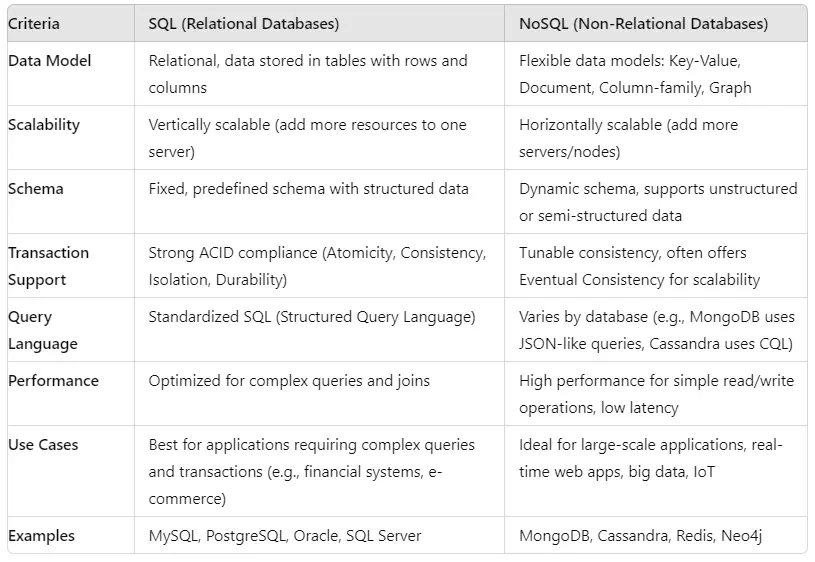SQL vs NoSQL: 7 Key Differences You Must Know for Choosing the Right Database 📊🆚🌐
In the modern world of data storage and management, choosing between SQL and NoSQL databases is a critical decision that can impact the performance, scalability, and future-proofing of your application. While both database types have their advantages, their core differences make each suitable for distinct use cases.
In this guide, we’ll explore the 7 key differences between SQL and NoSQL databases, helping you decide which is the best fit for your needs. Whether you’re building an e-commerce platform or a high-performance web app, understanding these differences will empower you to make an informed choice. Let’s dive in! 🏊♂️

1. Data Model 📋
SQL: Relational Data Model
In SQL databases, data is organized in a structured, tabular format known as the relational model. Each table consists of rows and columns, where rows represent individual records, and columns represent attributes of that data.
For example, an SQL database for a school management system may store students’ details in a table with columns like student_id, name, and age.
Visual Example:
Table (with rows and columns)
student_idnameage1Alice102Bob12
NoSQL: Flexible Data Models
On the other hand, NoSQL databases offer a variety of data models, giving you more flexibility. These include:
Key-Value stores (like Redis)
Document stores (like MongoDB)
Column-family stores (like Cassandra)
Graph databases (like Neo4j)
Each model is designed to handle specific types of data. For instance, Key-Value stores map unique keys to values, making them efficient for large-scale caching and quick lookups.
Visual Example:
Key-Value Store
Key: K1 -> Value: V1
Key: K2 -> Value: V2
💡 Pro Tip: If you need structured data with clear relationships, go for SQL. For more flexibility in storing various data types (especially unstructured data), NoSQL is your best bet.
2. Scalability ⚙️
SQL: Vertical Scalability-
SQL databases typically rely on vertical scaling, meaning you’ll need to upgrade your server’s CPU, RAM, or SSD to handle increased loads. This can be limiting and expensive at scale, especially as data volume and traffic grow.
For example, if your SQL-based e-commerce platform starts to lag, you may need to move to a more powerful server to maintain performance.
NoSQL: Horizontal Scalability
NoSQL databases are designed for horizontal scaling, allowing them to spread data across multiple servers or nodes. This distributed architecture makes NoSQL ideal for handling large-scale applications that need to accommodate millions (or billions) of users.
Instead of upgrading a single server, NoSQL databases like MongoDB or Cassandra can distribute the workload across multiple machines, making it easy to add more servers as your data grows.
💡 Pro Tip: Choose SQL if you have a smaller or medium-sized application that won’t require major scaling. For big data and high-growth applications, NoSQL’s horizontal scalability is more efficient and cost-effective.
3. Schema 🛠️
SQL: Rigid, Predefined Schema
In SQL databases, the schema (structure of tables, columns, and their data types) is defined beforehand and must be followed strictly. This makes SQL ideal for applications where data is highly structured and doesn’t change frequently, ensuring data consistency.
For example, if you want to store user information, you must define the table with fields like username (VARCHAR), email (VARCHAR), and age (INT) before inserting any data.
NoSQL: Dynamic Schema
NoSQL databases are highly flexible and often use a dynamic schema. This allows you to store different types of data without needing to define the structure beforehand. Each document (or record) can have its own schema, making NoSQL ideal for unstructured or evolving data.
For instance, in a NoSQL document database like MongoDB, one document can contain fields like name and age, while another document in the same collection can have completely different fields like address and phone_number.
Example (MongoDB Document):
json
{ "name": "Alice", "age": 30 }
json
{ "name": "Bob", "email": "bob@example.com" }
💡 Pro Tip: Choose SQL if you have a smaller or medium-sized application that won’t require major scaling. For big data and high-growth applications, NoSQL’s horizontal scalability is more efficient and cost-effective.
4. Transaction Support 💵
SQL: Strong ACID Compliance
SQL databases follow the ACID properties (Atomicity, Consistency, Isolation, Durability), which ensure that transactions are processed reliably. This is crucial for applications requiring strong data integrity, such as financial systems or e-commerce platforms.
Example: In an online shopping system, if you deduct an amount from a user’s account, but the transaction fails midway, ACID properties ensure that the entire operation is rolled back, preventing partial changes.
NoSQL: Tunable Consistency
Many NoSQL databases relax ACID compliance to favor scalability and high availability. While this might seem risky, some NoSQL databases offer tunable consistency models, allowing you to balance data integrity and performance depending on your needs.
For instance, Cassandra allows you to set different consistency levels (e.g., Eventual Consistency), where data updates are propagated gradually across all nodes, offering higher availability at the cost of immediate consistency.
💡 Pro Tip: For applications where data integrity is critical (e.g., banking or financial systems), go with SQL. If your app can tolerate eventual consistency, such as in social media or analytics, NoSQL might be a better choice.
5. Query Language 💬
SQL: Standardized Query Language
SQL databases use Structured Query Language (SQL), which is a powerful and standardized language used for querying and managing relational databases. SQL is known for performing complex queries, joins, and data manipulations across multiple tables with ease.
Example:
sql
SELECT * FROM customers WHERE age > 30;
NoSQL: Varies by Database
NoSQL databases don’t have a unified query language like SQL. Instead, each NoSQL system has its own query language or API, depending on the data model.
For instance, MongoDB uses a JSON-like query language, while Cassandra uses CQL (Cassandra Query Language), which is similar to SQL but optimized for Cassandra’s distributed architecture.
Example (MongoDB Query):
json
db.customers.find({ age: { $gt: 30 } })
💡 Pro Tip: SQL is perfect if you need to perform complex queries or are already familiar with relational databases. For NoSQL, you might need to learn new query languages, but they can be tailored for specific tasks.
6. Performance 🚀
SQL: Great for Complex Queries
SQL databases are optimized for performing complex queries that involve multiple joins, aggregations, and conditions. However, as the data volume grows, the performance can degrade, especially when executing joins across large tables.
NoSQL: High Performance for Simple Operations
NoSQL databases excel in read/write performance, especially for applications requiring simple queries or data retrieval. By avoiding complex joins and normalizing data across multiple tables, NoSQL can achieve low-latency operations even with large datasets.
💡 Pro Tip: Use SQL when your application requires complex query operations. If your app prioritizes fast, simple read/write operations over complex queries, NoSQL can offer superior performance.
7. Use Cases 🏗️
SQL: Best for Structured Data and Complex Transactions
SQL databases are ideal for applications where data is highly structured, and transactions require strict consistency. These include:
Financial systems (e.g., banking)
E-commerce platforms (e.g., Shopify)
Enterprise resource planning (ERP) systems
NoSQL: Perfect for Unstructured Data and Scalability
NoSQL databases shine in scenarios involving large volumes of unstructured data or when the application needs to scale quickly. Common use cases include:
Real-time web applications (e.g., Twitter, Instagram)
Big data analytics (e.g., Hadoop, Spark)
IoT data processing (e.g., sensor data storage)
💡 Pro Tip: For structured, high-consistency applications, go with SQL. For big data, rapidly changing data, or large-scale web apps, NoSQL is your best friend.
Conclusion: Which Database Is Right for You?
Both SQL and NoSQL databases have their strengths. Your choice ultimately depends on the type of application you’re building, the structure of your data, and your scalability needs.
If you require complex queries, strong consistency, and well-defined data structures, go with SQL.
If your application deals with unstructured data, needs high scalability, and flexibility, then NoSQL is likely the better option.
By understanding these 7 key differences, you’ll be able to select the right database solution that best fits your project needs.
























